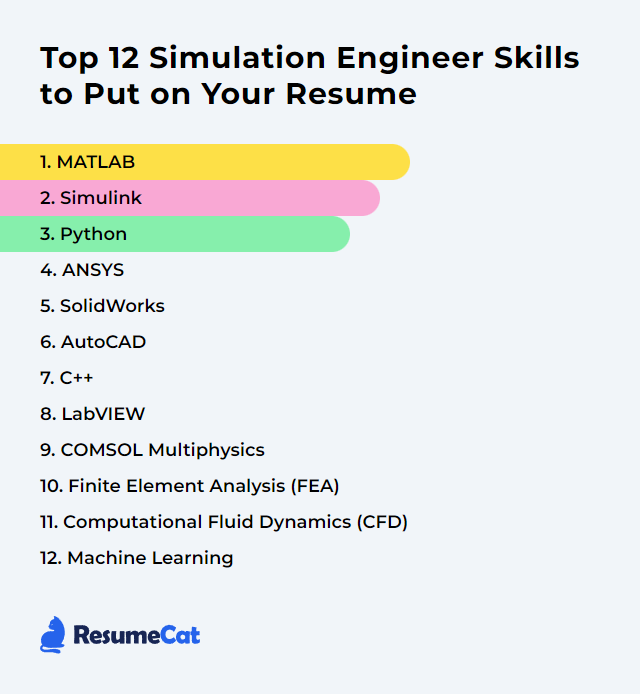Top 12 Simulation Engineer Skills to Put on Your Resume
In the competitive field of simulation engineering, showcasing a robust set of skills on your resume is crucial to standing out to potential employers. This article outlines a focused set of 12 skills that meaningfully strengthen a resume and help position you for modern simulation roles.
Simulation Engineer Skills
- MATLAB
- Simulink
- Python
- Ansys
- SolidWorks
- AutoCAD
- C++
- LabVIEW
- COMSOL Multiphysics
- Finite Element Analysis (FEA)
- Computational Fluid Dynamics (CFD)
- Machine Learning
1. MATLAB
MATLAB is a high-level programming and numerical computing environment used by simulation engineers for algorithm development, data analysis, visualization, and numerical simulation of complex engineering systems.
Why It's Important
MATLAB matters because it provides a fast, flexible space for designing, analyzing, and visualizing complex systems, which accelerates prototyping and iteration of simulation models.
How to Improve MATLAB Skills
Level up by tightening fundamentals and leaning into features that shrink run times and friction:
Strengthen core syntax: Revisit matrices, vectorization, indexing, and function handles until they’re second nature.
Pair with Simulink: For control and multidomain systems, build block-based models and co-simulate with your MATLAB code.
Use the right toolbox: Signal Processing, Optimization, Control System, Statistics—choose toolboxes aligned with your domain.
Write faster code: Preallocate, avoid growing arrays in loops, vectorize where possible, and profile to find bottlenecks.
Parallelize: parfor, batch, distributed arrays—split workloads cleanly to reduce wall-clock time.
Automate I/O: Build scripts for import/export pipelines and model setup so runs become repeatable and traceable.
Integrate: Exchange data with Python/C/C++, call external libraries, and wrap compiled code for speed when needed.
Stay current: Keep up with new releases; small features (tall arrays, timetable tricks) often unlock big gains.
Learn from others: Engage with user forums and examples; adapt patterns that fit your projects.
Ship quality: Add tests, docstrings, and reproducible demos so models are trustworthy and maintainable.
How to Display MATLAB Skills on Your Resume
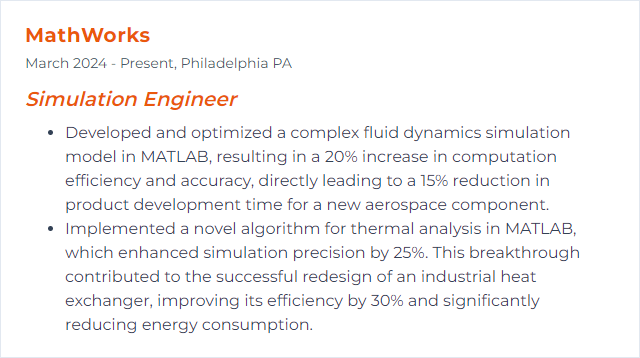
2. Simulink
Simulink is a MATLAB-based graphical environment for modeling, simulating, and analyzing multidomain dynamical systems. Its block diagrams make complex system design tangible and testable.
Why It's Important
It enables rapid model-based design, control development, and hardware-in-the-loop workflows that are painful to replicate with code-only approaches.
How to Improve Simulink Skills
Build reliable models that scale and survive handoffs:
Solid foundations: Data types, sample times, solver choices, and signal routing—master the plumbing.
Reusable libraries: Package common subsystems, parameter sets, and templates so teams don’t rebuild the same pieces.
Programmatic modeling: Use MATLAB scripts and the Simulink API to generate, modify, and test models automatically.
Model-Based Design: Embrace requirements linking, design reviews, and automatic code generation (Embedded Coder) when appropriate.
Verification tools: Leverage model coverage, signal logging, assertions, and test harnesses to catch regressions early.
Data dictionaries: Centralize parameters for consistency and configuration control across variants.
Performance tuning: Choose fixed-step vs. variable-step wisely, streamline triggered subsystems, and reduce algebraic loops.
Style guides: Adopt modeling standards so others can read, extend, and certify your work.
How to Display Simulink Skills on Your Resume
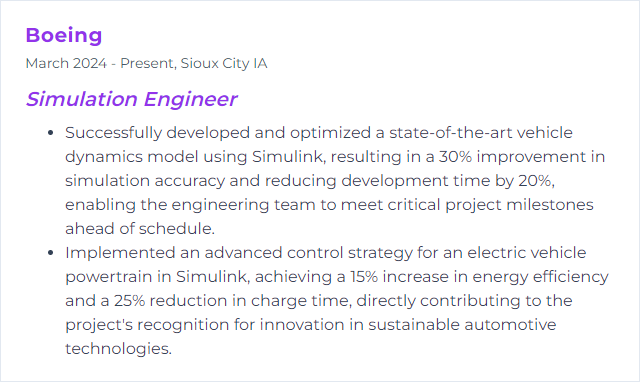
3. Python
Python is a versatile language used for simulation models, data handling, visualization, and automation. It shines thanks to its clear syntax and a deep scientific stack.
Why It's Important
NumPy, SciPy, pandas, Matplotlib, and Jupyter make rapid iteration simple; Cython/Numba push speed; bindings and APIs make Python glue together tools across your stack.
How to Improve Python Skills
Turn scripts into robust simulation tooling:
Core fluency: Master functions, iterables, comprehensions, context managers, and typing.
Scientific stack: Get comfortable with NumPy broadcasting, SciPy solvers/optimizers, and vectorized workflows.
Visualization: Build clear plots with Matplotlib/Seaborn; craft dashboards if stakeholders need live views.
Speed paths: Profile first; then consider Numba, Cython, or wrapping C/C++ hotspots.
Parallelism: Use multiprocessing, joblib, or Dask for embarrassingly parallel workloads.
Packaging: Manage environments, pin dependencies, and structure projects so they’re installable and testable.
Testing: Write unit and property tests (pytest), and add CI to prevent silent model drift.
Domain libraries: Explore PyDy, OpenMDAO, PySPH, or domain-specific frameworks aligned with your problems.
How to Display Python Skills on Your Resume
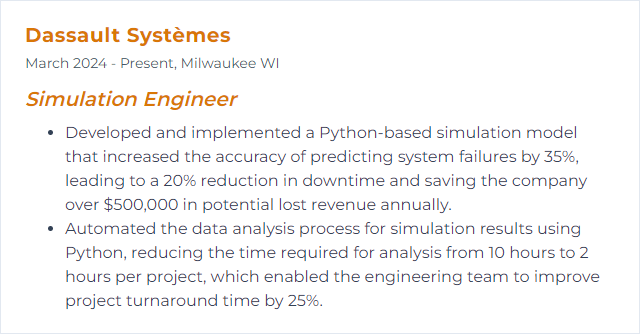
4. Ansys
Ansys is a comprehensive suite for engineering simulation—structures, fluids, electromagnetics, acoustics, and multiphysics—used to analyze and optimize product behavior before anything is built.
Why It's Important
It delivers accurate physics at scale, trims prototype counts, and shortens design loops across industries.
How to Improve Ansys Skills
Grow depth where it matters and automate the rest:
Foundations first: Geometry cleanup, contacts, meshing strategy, solver choices, and result interpretation.
Specialize: Fluent for CFD, Mechanical for FEA, and relevant add-ons—go deep in the module your projects demand.
Repeatability: Template projects, named selections, and parameter studies make iterative work painless.
Scripting: Use APDL or Python-based automation to standardize setup, runs, and post-processing.
Validation mindset: Correlate with experiments or hand calculations; adjust material models and boundary conditions accordingly.
HPC savvy: Configure parallel settings, partition meshes well, and scale runs on clusters efficiently.
Community and updates: Track release improvements and learn tricks from user groups and internal knowledge bases.
How to Display Ansys Skills on Your Resume

5. SolidWorks
SolidWorks is a CAD/CAE tool for creating 3D models and running simulations (stress, motion, thermal, fluids) to validate and refine designs before manufacturing.
Why It's Important
It connects parametric modeling with built-in simulation, letting engineers check form, fit, and function early—before errors get expensive.
How to Improve SolidWorks Skills
Model smarter, simulate cleaner:
Core modeling: Sketch constraints, configurations, design tables, and top-down assemblies reduce rework.
Simulation depth: Learn contacts, connectors, study types, and mesh controls; validate assumptions with simple subproblems.
Certification path: Target role-relevant certifications (e.g., CSWP, Simulation) to structure your study.
Custom libraries: Hardware libraries, fasteners, and common features save hours across projects.
Update cadence: New releases often bring solver and UI improvements worth adopting.
Practice variety: Tackle small consumer parts and large assemblies; your edge cases teach the most.
How to Display SolidWorks Skills on Your Resume
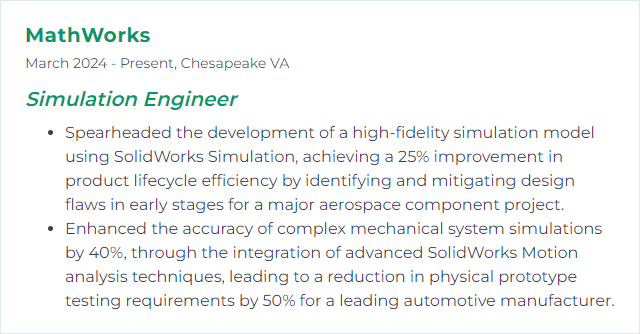
6. AutoCAD
AutoCAD is CAD software for precise 2D and 3D drawings of components, systems, and environments that feed downstream analysis and simulation.
Why It's Important
Accurate geometry is the backbone of trustworthy simulations. Clean drawings make meshing smoother and reduce rework.
How to Improve AutoCAD Skills
Trim friction and tighten consistency:
Customize your setup: Tailored ribbons, tool palettes, shortcuts, and templates speed repetitive tasks.
Standards and layers: Enforce naming, layers, lineweights, and blocks; clarity pays off in later stages.
Automation: Write scripts or AutoLISP routines for batch edits, exports, and checks.
Interoperability: Export clean STEP/IGES/DWG for CAE tools; verify units and tolerances before handoff.
Cloud collaboration: Use shared libraries and versioned drawings to keep teams aligned in real time.
How to Display AutoCAD Skills on Your Resume

7. C++
C++ is a high-performance language used to build complex, fast simulations with tight control over memory and execution.
Why It's Important
Large models, real-time constraints, custom solvers—C++ delivers the speed and determinism these workloads demand.
How to Improve C++ Skills
Write modern, measurable, portable code:
Modern C++: Use C++17/20/23 features—smart pointers, ranges, constexpr, structured bindings, coroutines—where they clarify and speed code.
STL mastery: Lean on algorithms, containers, and views before building bespoke structures.
Design discipline: Apply RAII, solid object modeling, and relevant patterns to keep complexity in check.
Concurrency: Threads, tasks, atomics, and executors; measure contention and cache behavior, not just wall time.
Numerics: Understand floating-point pitfalls, conditioning, and error propagation; pick stable methods.
Tooling: Use sanitizers, static analysis, benchmarking, and profilers to hunt defects and hotspots.
Build systems: CMake and cross-compilation skills keep multi-platform efforts sane.
Version control: Branching strategies, code review hygiene, and CI ensure quality scales with the team.
How to Display C++ Skills on Your Resume
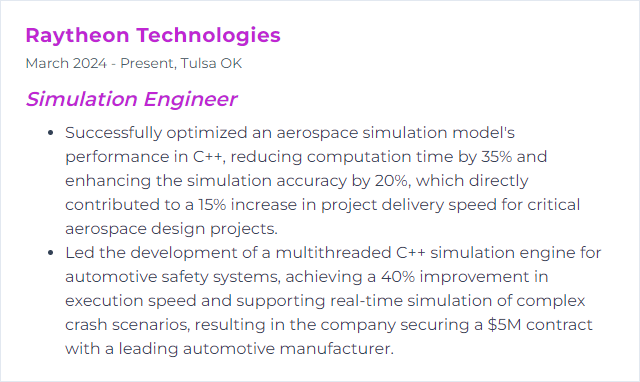
8. LabVIEW
LabVIEW is a graphical programming platform for designing, simulating, and analyzing systems—excellent for data acquisition, control, and hardware-in-the-loop setups.
Why It's Important
It enables quick prototyping, smooth hardware integration, and clear visualization—perfect for blending simulation with real-world I/O.
How to Improve LabVIEW Skills
Focus on scalable architectures and modern integrations:
Core fluency: Dataflow mindset, error clusters, queues/notifiers, and state machines form the backbone of robust VIs.
Simulation workflows: Use the Control Design and Simulation Module for plant models, controllers, and real-time testing.
Python and C interop: Prefer the Python Node or DLL calls over deprecated MathScript paths for advanced math.
Data handling: Stream large datasets efficiently; pick binary formats and manage memory consciously.
Performance: Minimize front-panel redraws in hot loops, preallocate arrays, and benchmark critical sections.
Networking: Build robust comms with TCP/UDP, shared variables, or message-based protocols for distributed sims.
Style and reuse: Adopt a project template, typedef controls, libraries, and strong naming so teams can collaborate confidently.
Hardware in the loop: Sync timing with DAQ/FPGA targets and validate closed-loop behavior under realistic latency.
How to Display LabVIEW Skills on Your Resume

9. COMSOL Multiphysics
COMSOL Multiphysics is a platform for modeling and solving coupled physics problems—FEA, CFD, electromagnetics, heat transfer, acoustics, and more.
Why It's Important
It makes multiphysics coupling straightforward, which is often where real systems live: thermal-mechanical, electro-thermal, fluid-structure.
How to Improve COMSOL Multiphysics Skills
Get comfortable with the modeling cycle and make it lean:
Start simple: Build a minimal model, confirm trends, then layer on complexity.
Application Libraries: Study example models close to your domain and adapt their patterns.
Meshing strategy: Local refinement where gradients spike; use symmetry and periodicity to cut cost.
Solver choices: Pick segregated vs. fully coupled wisely; tune tolerances and scaling for stability.
Parameters and sweeps: Drive studies with parameters, then mine results for sensitivities.
Optimization: Use built-in optimization and parametric studies to close design loops faster.
Stay current: New physics interfaces and numerics options can unlock dramatic run-time improvements.
How to Display COMSOL Multiphysics Skills on Your Resume
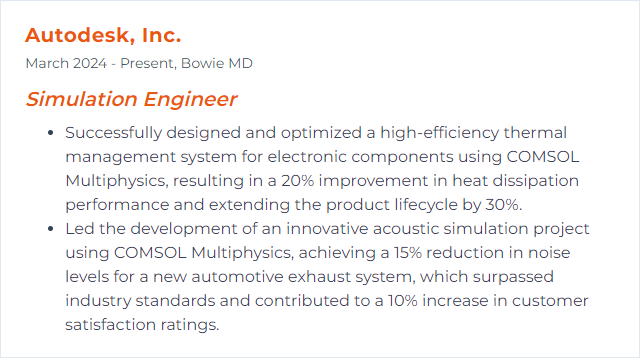
10. Finite Element Analysis (FEA)
FEA predicts responses of materials and structures to loads, heat, vibration, and other effects by discretizing domains into elements and solving governing equations numerically.
Why It's Important
It slashes prototype counts, surfaces failure modes early, and supports design decisions with quantifiable evidence.
How to Improve Finite Element Analysis (FEA) Skills
Accuracy first, efficiency next:
Mesh quality: Aim for low skew, appropriate aspect ratios, and targeted refinement in high-gradient regions.
Materials: Use correct elastic-plastic, viscoelastic, hyperelastic, or temperature-dependent models; calibrate when possible.
BCs that match reality: Constrain how parts are truly held; distribute loads realistically; avoid over-stiff fixtures.
Solver and convergence: Pick the right nonlinear settings, contact formulations, and convergence criteria; monitor residuals and energy balance.
Verification and validation: Compare with analytical solutions and test data; run mesh convergence studies and sensitivity analyses.
Post-processing discipline: Read stresses safely (nodal vs. element), check hot spots for mesh dependence, and report with context.
Scale up: Use HPC and parallel runs for big assemblies; partition models sensibly.
How to Display Finite Element Analysis (FEA) Skills on Your Resume
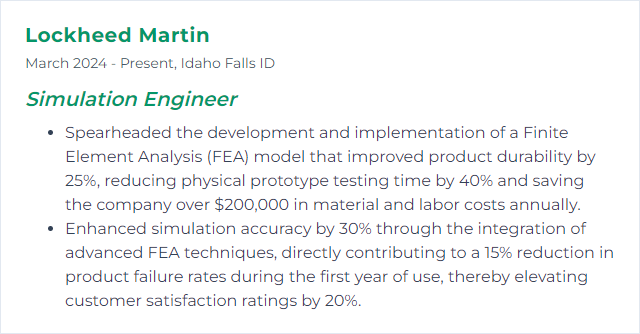
11. Computational Fluid Dynamics (CFD)
CFD solves fluid mechanics problems numerically to predict flows, heat transfer, and species transport, and to study how fluids interact with surfaces.
Why It's Important
It enables exploration of designs and operating conditions that are costly or impossible to prototype, giving insight into performance, efficiency, and safety.
How to Improve Computational Fluid Dynamics (CFD) Skills
Better physics, better meshes, better choices:
Mesh strategy: Resolve boundary layers (y+ targets), capture separation zones, and apply local refinement where gradients explode.
Model selection: Match turbulence models (RANS, SAS, LES) and compressibility/thermal models to the regime you’re in.
Boundary conditions: Use realistic inlets/outlets and wall treatments; ensure mass/energy balance checks close.
Temporal resolution: Choose steady vs. transient thoughtfully; pick time steps by CFL and physics, not habit.
Numerical schemes: Stabilize where needed, but watch dissipation; test discretization settings for bias.
V&V: Verify grid/time independence and validate against data; document uncertainty.
Speed and scale: Parallelize well, leverage HPC, and use solution initialization tricks for faster convergence.
Design loops: Tie in optimization/sensitivity methods to map design spaces with fewer full-fidelity runs.
How to Display Computational Fluid Dynamics (CFD) Skills on Your Resume
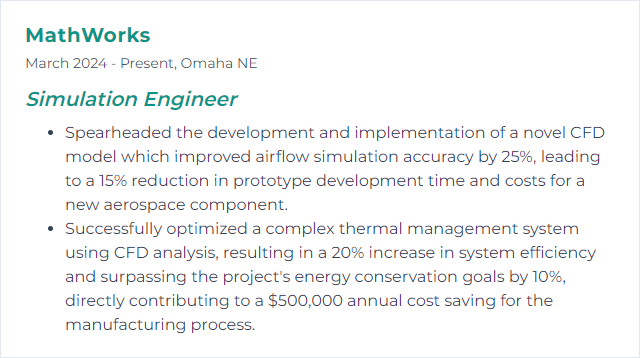
12. Machine Learning
Machine Learning lets models learn patterns from data to improve predictions, accelerate design loops, and even act as fast surrogates for expensive simulations.
Why It's Important
Surrogate modeling, reduced-order models, anomaly detection, and physics-informed approaches can slash compute cost while preserving fidelity where it counts.
How to Improve Machine Learning Skills
Grounded, practical, results-focused:
Data quality: Curate representative datasets, manage imbalance, and engineer features tied to the underlying physics.
Right model, right job: Try baselines first; escalate to ensembles, Gaussian processes, or neural nets when justified.
Hyperparameters: Systematically search; track experiments and compare with rigorous metrics.
Cross-validation: Use folds or time-based splits that reflect your deployment reality.
Uncertainty: Quantify prediction confidence with ensembling or probabilistic methods; propagate to design decisions.
Physics-informed: Inject constraints or loss terms reflecting conservation laws; blend data with governing equations.
MLOps basics: Version data and models, keep reproducible pipelines, and monitor drift over time.
How to Display Machine Learning Skills on Your Resume

